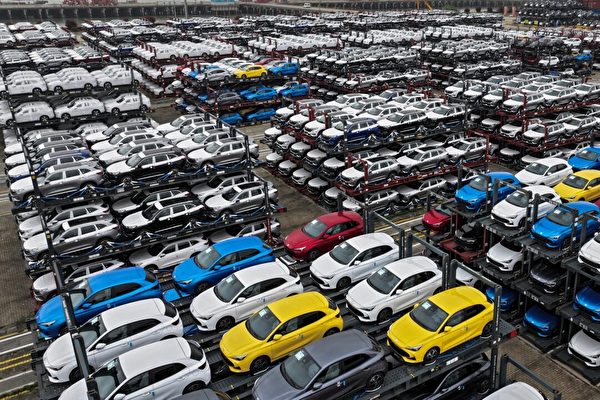In recent years, Communist China has garnered a notorious reputation on a global scale for leading an “axis of evil” composed of itself, Russia, Iran, North Korea, as well as Venezuela and Myanmar. This axis of evil group is shamelessly intimidating the citizens of its own country and neighboring nations.
However, to evade the sanctions and tariffs imposed by the United States on this axis group, the Chinese regime seems to prefer collaborating with partners that can be seen as the “second-tier” axis group, especially Mexico and Vietnam, but also including countries like Thailand, Egypt, Malaysia, and Hungary. China invests in these second-tier partners, manufactures overseas, and transports or transship exports to the United States and allied countries, including a majority of Chinese goods that should be subject to tariffs.
China’s investments in second-tier countries allow Chinese companies to continue producing and exporting large quantities of products to the U.S. and Western allies, disregarding tariffs and sanctions. This strategy rewards authoritarian regimes that maintain a reasonable distance politically and diplomatically from the Chinese regime, even if this distance is not as close as with other first-tier axis group members.
From the perspective of China’s export-oriented investment, countries can only oscillate between U.S. allies and existing first-tier axis group member countries. To China, the most suitable countries among these intermediaries to serve as channels for investment and trade towards the U.S. and Western allies are those that ideologically align closest with the Chinese regime, namely the second-tier axis group countries.
On the other hand, due to the economic sanctions or tariff restrictions imposed by the U.S. and Western allies, the economic development of first-tier axis group countries is hindered, driving them to seek to sell products abroad. Consequently, they become the best source choices for importing products for China. This gives Chinese companies leverage to bargain and obtain hefty discounts in the global market prices, benefiting mostly in the oil and natural gas energy markets. This also incentivizes China to push its limited import source countries to violate international law and norms, causing these countries to face Western sanctions, join the first-tier group, and be forced to sell products to China at discounted prices.
For example, it seems Beijing encouraged Moscow’s invasion of Ukraine in 2022. With the West imposing sanctions on Russia, almost no country dares to buy oil sanctioned by the West except China. China, aware of this, can demand and obtain discounts of up to 40%. This move is likely to ultimately provoke Moscow.
The fact that China uses its influence in this way shows that its partnerships with other members of the axis group are mainly transactional. The so-called axis group opposes “U.S. hegemony” and seeks “multipolarism” in ideology or values, more so to maximize each country’s power and territory than truly seek a multipolar world. Each member of the axis group country tends to lower the prices of other axis group members under the guise of “national interest,” like China lowering energy prices for Russia, despite Western sanctions on Russia due to its violation and redefinition of territorial integrity principles regarding Ukraine under Beijing’s tacit approval, as Beijing also attempts to redefine these principles at the expense of Taiwan.
Indeed, even democratic countries weaken each other, like European countries imposing limits on Ukrainian agricultural products. However, when democracies face external attacks, they should support each other better and provide security assistance, such as the U.S. providing military aid to Ukraine, Taiwan, and Israel.
Kimberly Donavan from the Atlantic Council based in Washington, D.C., appropriately calls the rogue trade network established by the first-tier axis group the “axis of evasion.” U.S. sanctions drive their trade away from legal partners towards each other, serving as a way to evade U.S. and Western allies’ sanctions and create an entire international shadow economy as their ships go unintercepted at sea. However, for China’s investment aimed at expanding exports to the U.S., EU, Japan, and other allied markets, the risks associated with the first-tier axis group members are too great due to the possibility of being subjected to the Western world’s economic sanctions.
Therefore, China’s export investment strategy towards the U.S. and Western allies must differ from its trade and investment strategy with other first-tier axis group member countries, which aims to support the trade of the host country, such as the forceful promotion of the Belt and Road Initiative infrastructure construction.
China’s strategy of exporting to the U.S. and Western allies clearly directs its export investments towards second-tier partners that are unlikely to face tariffs or accept Western sanctions but are still relatively pro-Beijing government. As a result, the Chinese government gains international political benefits, indicating to other countries that have yet to benefit from such investments that they too could benefit if their policies align closely with China. This way, the Chinese regime has a propaganda incentive consistent with China’s national interests, thereby enhancing its political influence abroad. Considering that the U.S. and its Western allies have not explicitly called on countries to choose sides in the superpower conflict between China and the U.S., there are hardly any restraining factors.
Perhaps it is time to change this situation. Perhaps it is time to follow the clear message conveyed by the leaders of both the Republican and Democratic parties in the global war on terrorism to countries worldwide: either support us or oppose us.

